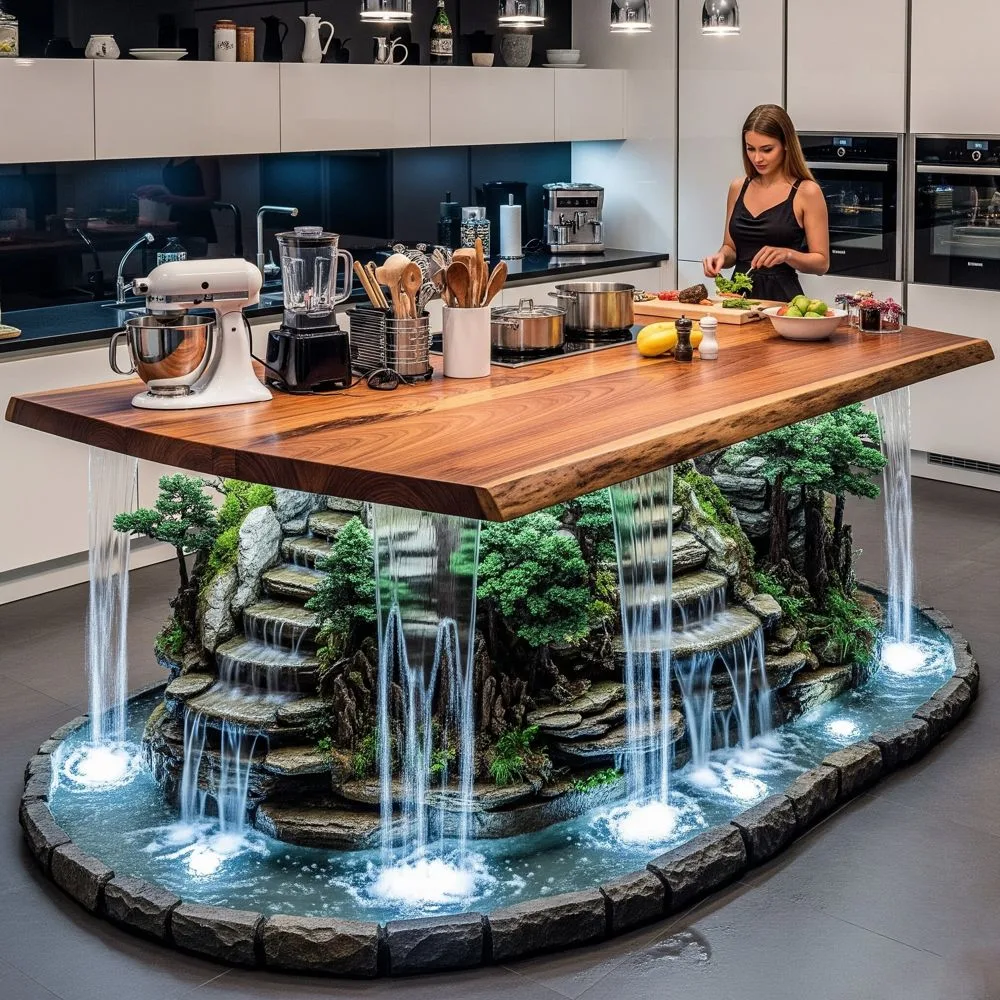Kitchen islands with waterfalls have emerged as one of the most sought after design elements in contemporary home renovation. This striking architectural feature transforms an ordinary kitchen island into a sophisticated focal point that seamlessly blends functionality with aesthetic appeal. The waterfall design creates a continuous flow of countertop material that cascades down one or both sides of the island, forming a sleek vertical surface that resembles a natural waterfall.
The growing popularity of kitchen islands with waterfalls stems from their ability to elevate any kitchen space while providing practical benefits. Whether you’re planning a complete kitchen overhaul or simply looking to upgrade your existing island, understanding the nuances of waterfall design can help you make informed decisions that enhance both the beauty and value of your home.
What Are Kitchen Islands With Waterfalls?
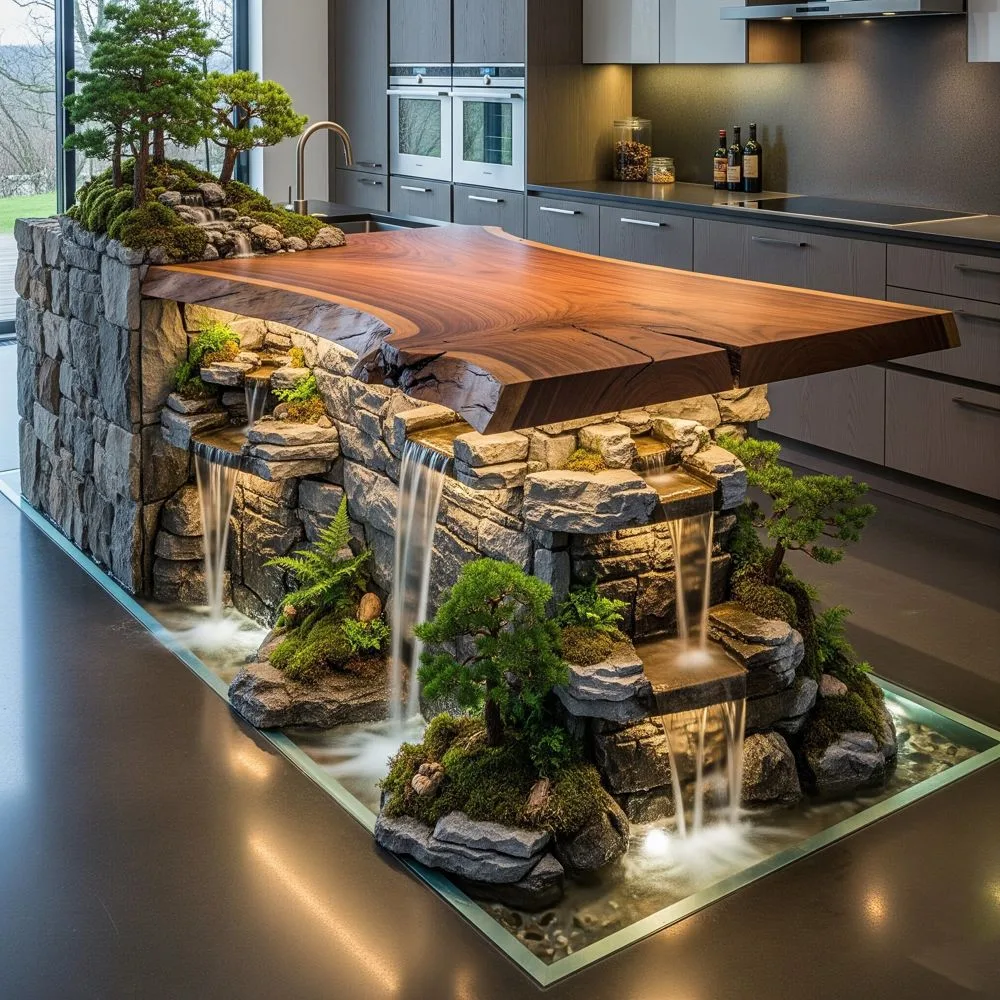
Kitchen islands with waterfalls feature countertop material that extends vertically down to the floor on one or both ends of the island. Unlike traditional kitchen islands where the countertop sits atop a base cabinet structure, waterfall islands create an uninterrupted visual line from the horizontal surface to the floor. This design technique eliminates the need for decorative end panels and creates a monolithic appearance that exudes modern sophistication.
The waterfall edge can be implemented in various ways, from a single side application to a dramatic double waterfall that covers both ends of the island. The choice depends on your kitchen layout, design preferences, and budget considerations. Many homeowners opt for a single waterfall edge on the seating side of their island to create a stunning backdrop for bar stools while maintaining storage accessibility on the opposite side.
The Evolution of Waterfall Design
The concept of waterfall countertops originated in high end commercial spaces and luxury hotels before making its way into residential kitchens. Interior designers embraced this technique as a way to create visual continuity and eliminate the busy appearance that traditional cabinetry can sometimes produce. Today, kitchen islands with waterfalls represent the pinnacle of modern kitchen design, offering a perfect balance between form and function.
Design Benefits of Kitchen Islands With Waterfalls
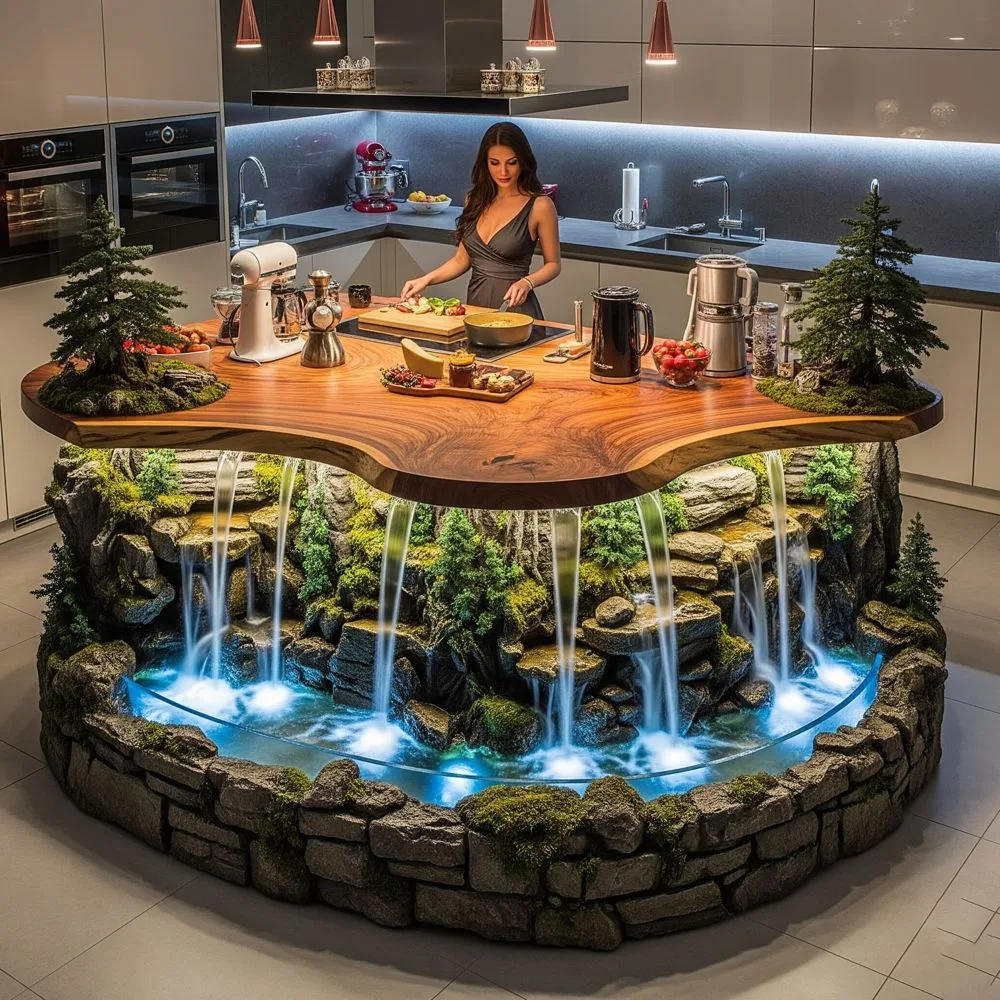
Visual Impact and Aesthetic Appeal
Kitchen islands with waterfalls serve as dramatic focal points that immediately draw attention and create a sense of luxury. The continuous flow of material creates clean lines that complement contemporary and transitional design styles. This uninterrupted surface allows the natural beauty of materials like marble, quartz, or granite to shine, showcasing unique veining patterns and color variations across a larger canvas.
The vertical application of premium countertop materials adds architectural interest and can make your kitchen appear larger and more open. The sleek profile of waterfall islands contributes to the minimalist aesthetic that many modern homeowners desire, creating a sophisticated look that feels both timeless and cutting edge.
Increased Property Value
Installing kitchen islands with waterfalls can significantly boost your home’s market value. Real estate professionals consistently report that luxury kitchen features, particularly those involving premium materials and contemporary design, offer excellent return on investment. The dramatic visual impact of a waterfall island often becomes a selling point that sets your property apart from comparable homes in the market.
Potential buyers frequently view waterfall islands as indicators of overall home quality and attention to detail. The presence of such a distinctive design element suggests that the homeowner has invested in high end finishes throughout the property, which can justify higher asking prices and generate more interest from qualified buyers.
Functional Advantages
Beyond their aesthetic appeal, kitchen islands with waterfalls offer several practical benefits. The extended countertop material provides additional protection for the island’s base structure, acting as a barrier against spills, scratches, and everyday wear. This protection is particularly valuable in busy kitchens where the island serves multiple functions.
The seamless surface is easier to clean and maintain compared to traditional islands with multiple joints and seams. The continuous material eliminates crevices where crumbs and spills might accumulate, making daily maintenance more straightforward and hygienic.
Popular Materials for Kitchen Islands With Waterfalls
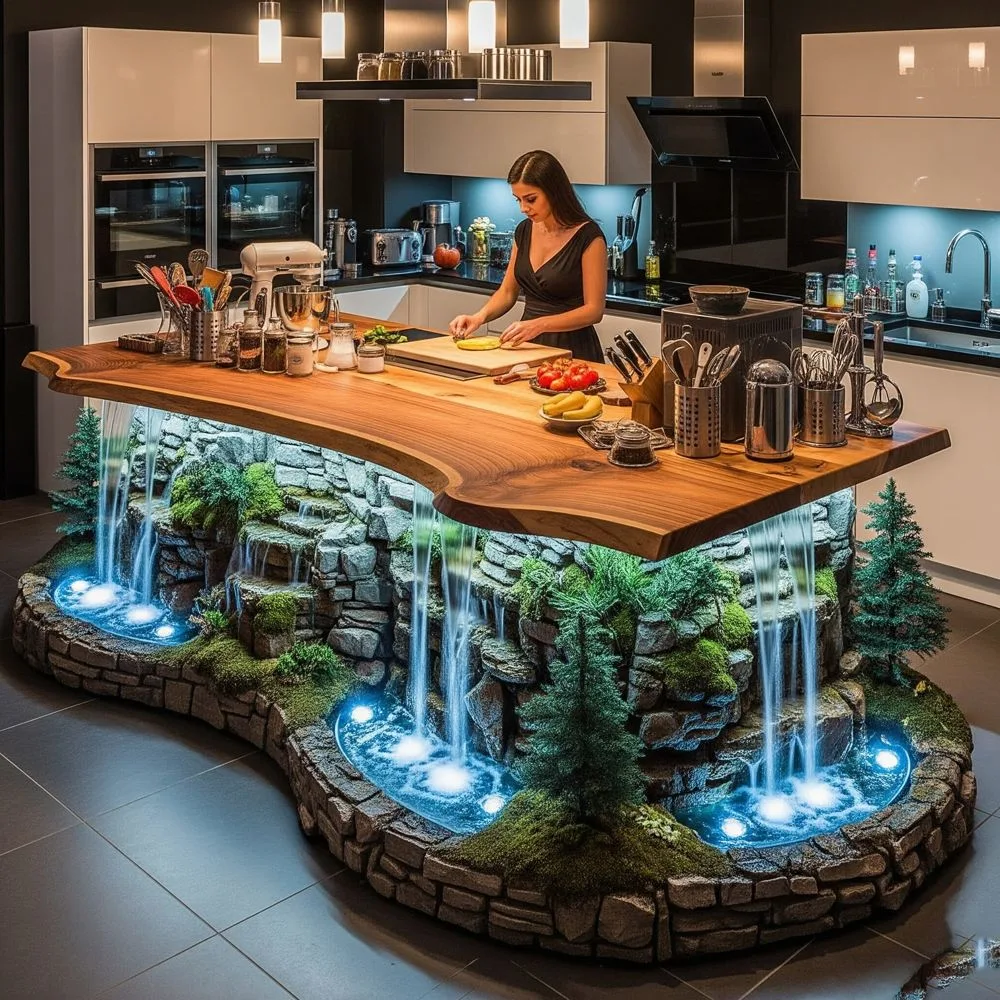
Quartz Countertops
Engineered quartz has become the preferred material for kitchen islands with waterfalls due to its durability, consistency, and wide range of design options. Unlike natural stone, quartz slabs offer uniform patterns and colors, making it easier to achieve seamless waterfall installations. The non-porous surface resists stains, scratches, and bacterial growth, making it ideal for high-traffic kitchen environments.
Modern quartz manufacturers offer slabs in larger sizes, reducing the need for seams in waterfall applications. Popular quartz brands like Caesarstone, Silestone, and Cambria provide extensive collections that mimic natural stone patterns while offering superior performance characteristics. The consistency of engineered quartz also makes it easier for fabricators to match grain patterns across horizontal and vertical surfaces.
Natural Stone Options
Marble remains a coveted choice for kitchen islands with waterfalls, particularly varieties like Calacatta, Carrara, and Statuario that feature dramatic veining. The key to successful marble waterfall installations lies in careful slab selection to ensure complementary vein patterns flow naturally from horizontal to vertical surfaces. While marble requires more maintenance than engineered materials, its unparalleled beauty and uniqueness make it worthwhile for many homeowners.
Granite offers another natural stone option that works well for waterfall applications. Dense granite varieties provide excellent durability while showcasing unique patterns and colors that cannot be replicated in engineered materials. The challenge with granite lies in finding slabs large enough to minimize seams and achieve the continuous look that defines waterfall design.
Alternative Materials
Porcelain slabs have gained popularity for kitchen islands with waterfalls due to their large format availability and realistic stone patterns. Ultra-thin porcelain slabs can create dramatic waterfall effects while reducing weight and cost compared to natural stone alternatives. These materials offer excellent stain resistance and durability while providing design flexibility.
Solid surface materials like Corian can be fabricated to create seamless waterfall installations with integrated features like built-in lighting or heating elements. While less luxurious than stone options, solid surfaces offer practical benefits and unlimited design possibilities through custom fabrication techniques.
Installation Considerations for Kitchen Islands With Waterfalls
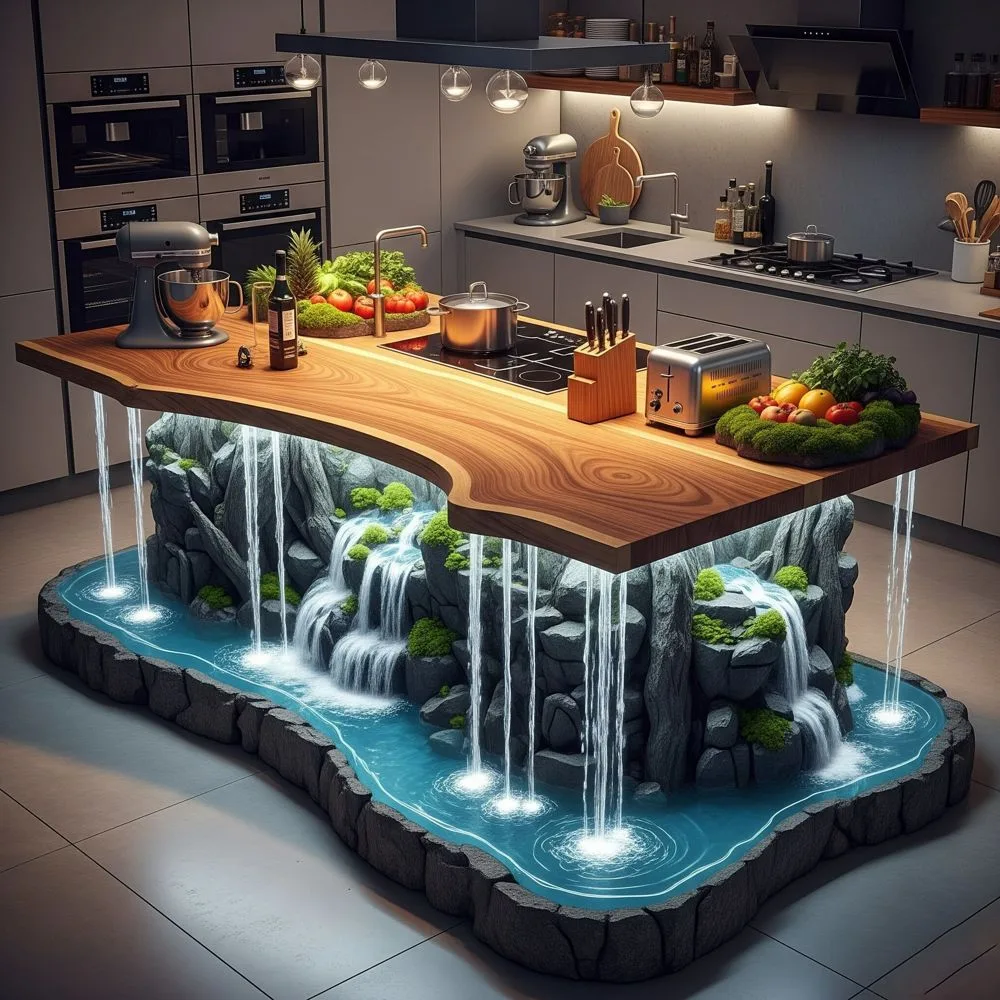
Structural Requirements
Kitchen islands with waterfalls require careful planning to ensure adequate structural support for the vertical stone panels. The weight distribution differs significantly from traditional islands, as the waterfall edge creates a cantilever effect that must be properly engineered. Professional consultation is essential to determine if additional reinforcement is needed in your floor structure.
The installation process typically requires experienced fabricators who understand the complexities of matching stone patterns and creating invisible seams. The precision required for waterfall installations exceeds that of standard countertop projects, making professional installation crucial for achieving the desired aesthetic result.
Electrical and Plumbing Considerations
Planning for electrical outlets and plumbing connections becomes more complex with kitchen islands with waterfalls. The continuous surface limits access points for utilities, requiring careful coordination between trades during installation. Many designers recommend incorporating pop-up electrical outlets or hidden charging stations to maintain the clean aesthetic while providing necessary functionality.
Plumbing rough-in for waterfall islands must account for the vertical stone panels and potential interference with waste lines or water supply connections. Early planning and coordination between your designer, contractor, and stone fabricator can prevent costly modifications during construction.
Cost Factors and Budget Planning
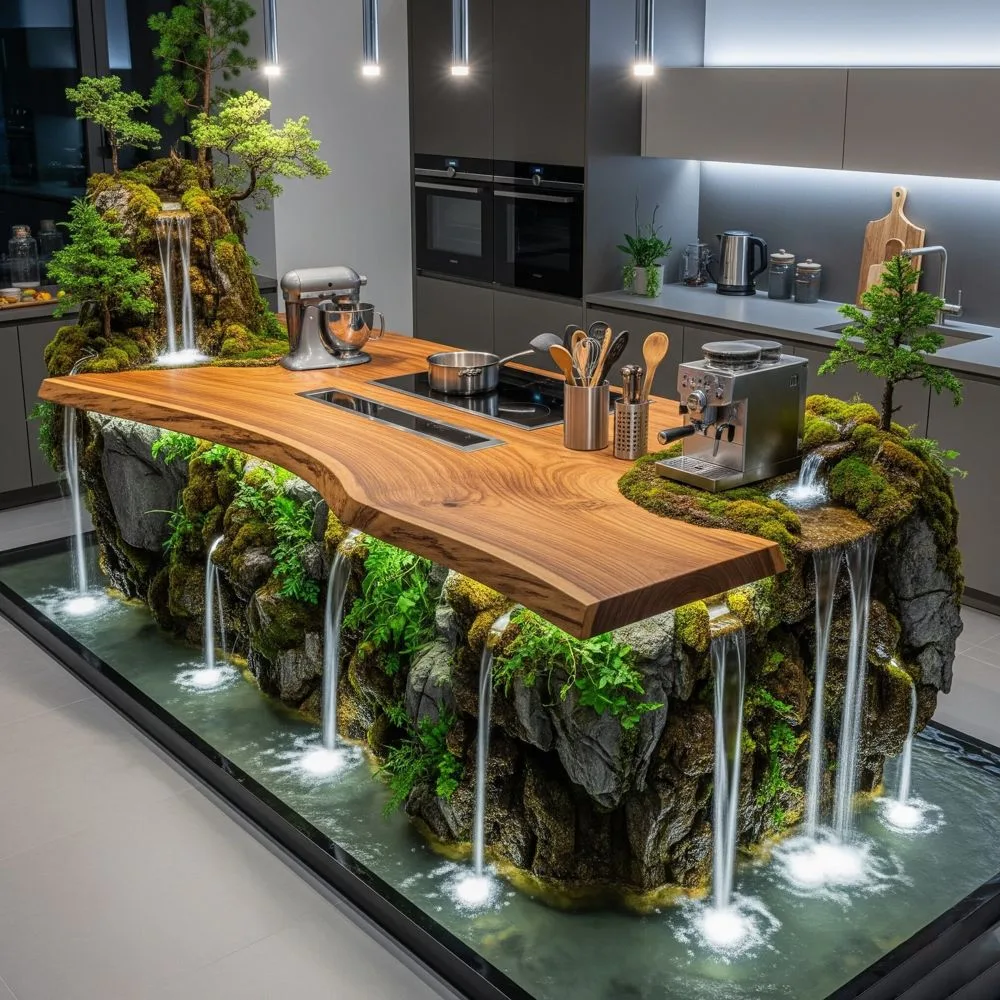
Material Costs
The cost of kitchen islands with waterfalls varies significantly based on material selection, size, and complexity. Premium materials like exotic marbles or high-end quartz can range from $80 to $150 per square foot, while more affordable options might cost $40 to $70 per square foot. Remember that waterfall installations require additional square footage of material compared to traditional islands, impacting overall project costs.
Template creation, fabrication complexity, and installation requirements add to the base material costs. The precision required for waterfall installations often commands premium pricing from fabricators, as the skill level and time investment exceed standard countertop projects.
Installation and Labor Expenses
Professional installation of kitchen islands with waterfalls typically costs more than traditional countertop installations due to the complexity and precision required. Experienced fabricators charge premium rates for waterfall projects, reflecting the specialized skills and equipment needed for successful installation.
Additional costs may include structural modifications, electrical work, and coordination with other trades. Budget-conscious homeowners should factor in these ancillary expenses when planning their waterfall island project to avoid unexpected cost overruns.
Maintenance and Care Tips
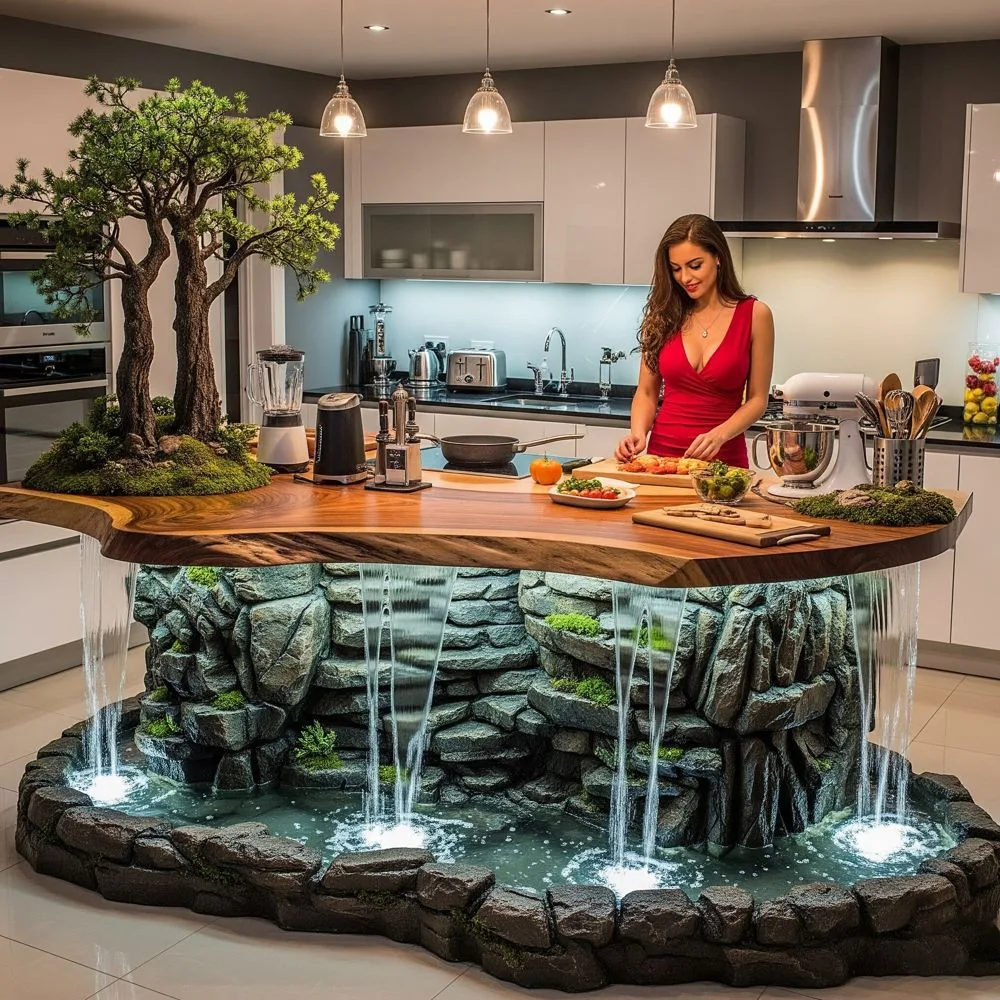
Daily Cleaning Routines
Maintaining kitchen islands with waterfalls requires attention to both horizontal and vertical surfaces. Daily cleaning should include wiping down the entire waterfall edge to prevent buildup of cooking residue, fingerprints, and water spots. Use pH-neutral cleaners appropriate for your specific countertop material to avoid damage to the surface finish.
Pay special attention to the junction between horizontal and vertical surfaces, as this area can collect debris and require more thorough cleaning. Microfiber cloths work well for both cleaning and drying waterfall surfaces without leaving streaks or lint behind.
Long Term Care Strategies
Different materials used in kitchen islands with waterfalls require specific long term maintenance approaches. Natural stone surfaces may need periodic sealing to maintain stain resistance, while engineered materials typically require less intensive care. Establish a maintenance schedule based on your material choice and usage patterns.
Regular inspection of seams and joints helps identify potential issues before they become costly problems. Professional maintenance services can provide deep cleaning, sealing, and minor repairs to keep your waterfall island looking pristine for years to come.
Design Integration and Style Compatibility
Contemporary and Modern Kitchens
Kitchen islands with waterfalls naturally complement contemporary and modern design aesthetics through their clean lines and minimalist appearance. The uninterrupted surface aligns perfectly with the principles of modern design, creating focal points without visual clutter. Pairing waterfall islands with handleless cabinetry, integrated appliances, and neutral color palettes creates cohesive modern kitchen environments.
The geometric nature of waterfall design works particularly well with other contemporary elements like linear lighting, flat-panel cabinet doors, and sleek hardware selections. This harmony creates sophisticated kitchen spaces that feel intentionally designed rather than assembled from disparate elements.
Transitional Design Applications
Transitional kitchens benefit from kitchen islands with waterfalls as bridge elements between traditional and contemporary styles. The clean profile of waterfall design can soften the visual weight of traditional cabinetry while adding contemporary flair to classic kitchen layouts. Material selection plays a crucial role in achieving successful transitional integration.
Natural stone waterfall islands work particularly well in transitional settings, as the organic patterns and colors complement both traditional and contemporary design elements. Careful coordination of finishes, hardware, and lighting ensures that the waterfall island enhances rather than conflicts with the overall design direction.
Common Design Mistakes to Avoid
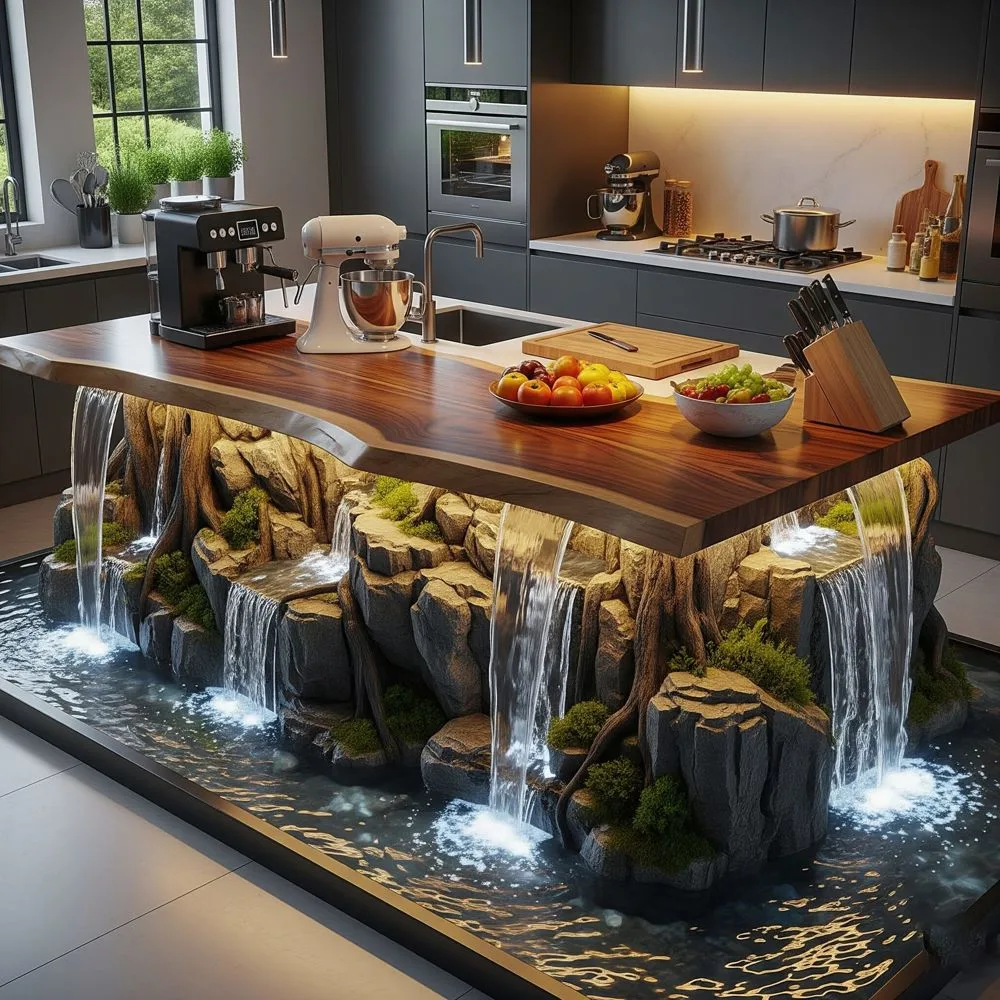
Proportion and Scale Issues
One of the most common mistakes in kitchen islands with waterfalls involves proportion and scale mismatches. Oversized waterfall islands can overwhelm smaller kitchens, while undersized islands may appear insignificant in large spaces. Proper planning considers the relationship between island size, room dimensions, and traffic flow patterns.
The thickness of waterfall edges must also be proportionate to the overall island size and room scale. Thin edges may appear fragile in substantial kitchens, while overly thick profiles can seem bulky and overwhelming in more intimate spaces.
Material Selection Errors
Choosing inappropriate materials for kitchen islands with waterfalls can lead to maintenance challenges and aesthetic disappointment. High-maintenance materials like unpolished marble may not suit busy family kitchens, while overly casual materials might not provide the luxury impact that justifies the investment in waterfall design.
Consider your lifestyle, maintenance preferences, and long term goals when selecting materials for waterfall islands. The most beautiful material becomes a liability if it cannot withstand your family’s usage patterns or requires more maintenance than you can reasonably provide.
Future Trends in Kitchen Island Design
Technology Integration
Emerging trends in kitchen islands with waterfalls include seamless technology integration that maintains the clean aesthetic while providing modern functionality. Hidden charging stations, integrated lighting systems, and smart home connectivity are becoming standard features in luxury waterfall installations.
Touch-activated surfaces, built-in wireless charging zones, and concealed electrical outlets represent the future of waterfall island design. These innovations preserve the minimalist appearance while enhancing functionality for modern lifestyles.
Sustainable Material Options
Environmental consciousness is driving innovation in materials suitable for kitchen islands with waterfalls. Recycled glass surfaces, sustainable quartz formulations, and reclaimed stone options provide eco-friendly alternatives without compromising aesthetic appeal.
Manufacturers are developing new materials that combine sustainability with performance, offering environmentally responsible choices for luxury kitchen applications. These developments ensure that waterfall islands can align with green building practices and LEED certification requirements.
Conclusion
Kitchen islands with waterfalls represent the perfect fusion of form and function in contemporary kitchen design. These striking architectural elements transform ordinary kitchens into sophisticated spaces that serve as both functional work areas and stunning focal points. The investment in waterfall design pays dividends through increased property value, enhanced aesthetic appeal, and improved daily kitchen experiences.
The key to successful waterfall island implementation lies in careful planning, appropriate material selection, and professional installation. By understanding the design principles, cost considerations, and maintenance requirements outlined in this comprehensive guide, you can make informed decisions that result in a waterfall island that exceeds your expectations and serves your family for years to come.
Whether you’re drawn to the dramatic veining of natural marble, the consistency of engineered quartz, or the innovation of alternative materials, kitchen islands with waterfalls offer endless possibilities for creating truly exceptional kitchen spaces. The time invested in proper planning and the commitment to quality materials and installation will reward you with a kitchen centerpiece that combines timeless elegance with contemporary functionality.
As kitchen design continues to evolve, waterfall islands remain at the forefront of luxury trends, representing the sophisticated approach to space planning that modern homeowners demand. The seamless integration of beauty and practicality that defines kitchen islands with waterfalls ensures their continued popularity among discerning homeowners who appreciate the finest in contemporary design.

